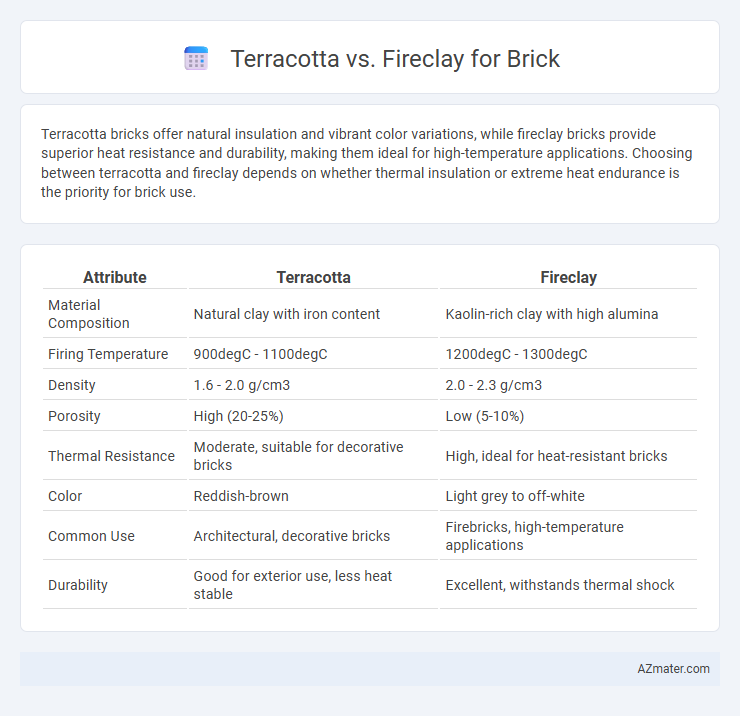Terracotta bricks offer natural insulation and vibrant color variations, while fireclay bricks provide superior heat resistance and durability, making them ideal for high-temperature applications. Choosing between terracotta and fireclay depends on whether thermal insulation or extreme heat endurance is the priority for brick use.
Table of Comparison
| Attribute | Terracotta | Fireclay |
|---|---|---|
| Material Composition | Natural clay with iron content | Kaolin-rich clay with high alumina |
| Firing Temperature | 900degC - 1100degC | 1200degC - 1300degC |
| Density | 1.6 - 2.0 g/cm3 | 2.0 - 2.3 g/cm3 |
| Porosity | High (20-25%) | Low (5-10%) |
| Thermal Resistance | Moderate, suitable for decorative bricks | High, ideal for heat-resistant bricks |
| Color | Reddish-brown | Light grey to off-white |
| Common Use | Architectural, decorative bricks | Firebricks, high-temperature applications |
| Durability | Good for exterior use, less heat stable | Excellent, withstands thermal shock |
Introduction to Terracotta and Fireclay Bricks
Terracotta bricks are made from natural clay baked at lower temperatures, resulting in a porous, softer material ideal for decorative and non-load-bearing applications. Fireclay bricks, produced by firing fire-resistant clay at extremely high temperatures, offer superior durability and thermal resistance, making them suitable for high-temperature environments like kilns and fireplaces. Understanding the distinct composition and firing processes helps determine the best brick type for specific construction needs.
Composition and Material Differences
Terracotta bricks are primarily composed of natural clay mixed with water and fired at lower temperatures around 1,000-1,150degC, resulting in a porous and lightweight material ideal for decorative facades. Fireclay bricks contain high levels of alumina and silica and are fired at much higher temperatures exceeding 1,200degC, producing a dense, highly durable, and heat-resistant material suitable for industrial and high-temperature applications. The key material difference lies in fireclay's enhanced thermal stability and mechanical strength compared to the more aesthetically focused, porous structure of terracotta.
Manufacturing Processes Compared
Terracotta bricks are manufactured by shaping natural clay and firing it at temperatures between 900degC and 1100degC, resulting in a porous, lightweight, and decorative material. Fireclay bricks involve refractory clay mixed with fire-resistant materials and are fired at higher temperatures, typically around 1400degC to 1600degC, producing dense, durable bricks with superior heat resistance. The manufacturing process differences impact terracotta's suitability for ornamental purposes, while fireclay bricks are preferred for high-temperature industrial applications.
Strength and Durability Analysis
Terracotta bricks exhibit moderate strength with good aesthetic appeal but are generally less durable compared to fireclay bricks, which possess high compressive strength and exceptional resistance to thermal shock and wear. Fireclay bricks withstand intense heat and chemical exposure, making them ideal for industrial and high-temperature applications, while terracotta is more suited for decorative and low-stress environments. The dense, vitrified structure of fireclay bricks results in superior durability and longevity under harsh conditions compared to the more porous terracotta material.
Aesthetic Appeal and Color Variation
Terracotta bricks offer a warm, earthy aesthetic with natural variations in red and orange tones that enhance rustic and traditional architectural styles. Fireclay bricks provide a broader color spectrum, including deep reds, browns, and even blues, allowing for more customized and vibrant design options. The unique mineral composition of fireclay results in smoother textures and richer colors, making it ideal for projects emphasizing both durability and visual impact.
Thermal and Moisture Resistance
Terracotta bricks offer moderate thermal insulation but have higher porosity, resulting in lower moisture resistance compared to fireclay bricks that exhibit superior thermal stability and lower water absorption rates. Fireclay bricks withstand extreme temperature fluctuations and retain structural integrity in wet environments due to their dense composition and vitrification process. The enhanced thermal mass and minimal moisture permeability of fireclay bricks make them ideal for applications requiring durable heat retention and resistance to moisture-related deterioration.
Installation and Maintenance Requirements
Terracotta bricks require minimal installation effort due to their lightweight nature, allowing for faster handling and setting compared to the denser fireclay bricks. Fireclay bricks demand more precise installation techniques and stronger mortar adherence because of their higher density and heat resistance properties. Maintenance for terracotta is generally simpler, focusing on surface cleaning, whereas fireclay bricks benefit from periodic inspections to manage potential cracks and maintain structural integrity under high-temperature conditions.
Environmental Impact and Sustainability
Terracotta bricks, made from natural clay and fired at lower temperatures, offer a lower carbon footprint and enhanced energy efficiency during production compared to fireclay bricks, which require higher firing temperatures and more energy. Both materials are recyclable and biodegradable, but terracotta's porous nature promotes breathability, reducing mold growth and housing energy needs. Fireclay bricks, known for durability and thermal resistance, have a longer lifespan, potentially offsetting their initial higher environmental cost through reduced replacement frequency.
Cost Comparison: Terracotta vs Fireclay
Terracotta bricks generally cost less than fireclay bricks due to lower material and manufacturing expenses, making them a budget-friendly choice for many construction projects. Fireclay bricks, known for their high durability and resistance to heat, come with a higher price tag reflecting their enhanced performance and longer lifespan. When balancing upfront cost against long-term value, fireclay bricks may offer better cost efficiency despite the higher initial investment.
Best Applications and Usage Recommendations
Terracotta bricks excel in decorative applications due to their rich color variations and smooth texture, making them ideal for facades, architectural accents, and ornamental work. Fireclay bricks offer superior heat resistance and durability, suited for high-temperature environments such as fireplaces, kilns, and industrial furnaces. For outdoor structural use, fireclay's strength and low porosity provide enhanced weather resistance, while terracotta remains preferred for aesthetic features and light-duty cladding.

Infographic: Terracotta vs Fireclay for Brick
 azmater.com
azmater.com